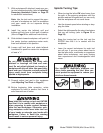
-32-
Model T25920/T25926 (Mfd. Since 08/14)
Review the troubleshooting and procedures in this section to fix or adjust your machine if a problem devel-
ops. If you need replacement parts or you are unsure of your repair skills, then feel free to call our Technical
Support at (570) 546-9663.
SECTION 7: SERVICE
Troubleshooting
Motor & Electrical
Symptom Possible Cause Possible Solution
Machine does not
start or a breaker
trips.
1. Switch disabling key removed.
2. Incorrect power supply voltage or circuit
size.
3. Blown fuse.
4. Power supply circuit breaker tripped or fuse
blown.
5. Wiring is open/has high resistance.
6. Potentiometer/variable-speed dial at fault.
7. ON/OFF switch at fault.
8. Motor brushes at fault.
9. Motor is at fault.
1. Install switch disabling key.
2. Ensure correct power supply voltage and circuit
size.
3. Replace fuse/ensure no shorts.
4. Ensure circuit is sized correctly and free of shorts.
Reset circuit breaker or replace fuse.
5. Check for broken wires or disconnected/corroded
connections, and repair/replace as necessary.
6. Test/replace.
7. Replace switch.
8. Replace motor brushes.
9. Test/repair/replace.
Machine stalls or is
underpowered.
1. Machine is undersized for task.
2. Workpiece material not suitable.
3. Feed rate/cutting speed too fast for task.
4. Belt slipping.
5. Motor connection is wired incorrectly.
6. Pulley slipping on shaft.
7. Plug/receptacle at fault.
8. Motor has overheated.
9. Potentiometer/variable-speed dial at fault.
10. Motor brushes at fault.
11. Pulley/sprocket slipping on shaft
12. Motor is at fault.
1. Use sharp lathe tools; reduce feed rate/depth of cut.
2. Only cut wood/ensure moisture is below 20%.
3. Decrease feed rate/cutting speed.
4. Replace bad belt and re-tension (see Page 34).
5. Correct motor wiring connections.
6. Replace loose pulley.
7. Test for good contacts/correct wiring.
8. Clean off motor, let cool, and reduce workload.
9. Test/replace.
10. Replace motor brushes.
11. Replace loose pulley/shaft.
12. Test/repair/replace.
Machine has
vibration or noisy
operation (without
workpiece installed).
1. Machine incorrectly mounted to workbench
or floor.
2. Motor or component is loose.
3. Belt worn or loose.
4. Motor mount loose/broken.
5. Pulley is loose.
6. Motor bearings are at fault.
7. Workpiece or chuck at fault.
1. Adjust feet, shim, or tighten mounting hardware.
2. Inspect/replace stripped or damaged bolts/nuts, and
re-tighten with thread locking fluid-4
3. Inspect/replace belts (see Page 34).
4. Tighten/replace.
5. Replace shaft, pulley, setscrew, and key as
required.
6. Test by rotating shaft; rotational grinding/loose shaft
requires bearing replacement.
7. Center workpiece in chuck/faceplate; reduce RPM;
replace defective chuck.


















